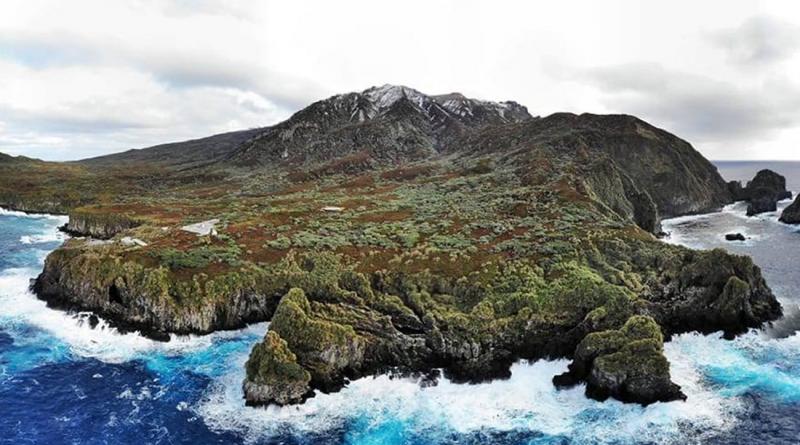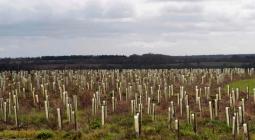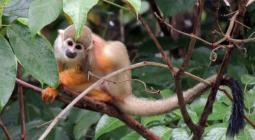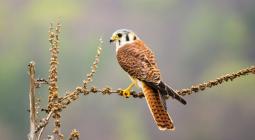Should we cull one species to save another?

Large mice are devastating rare birds on a tiny island, now moves are afoot to exterminate the rodents. But should conservation ever be about killing?
Gough Island is about as remote a fragment of land as it is possible to find on a map. Its 91 square kilometres of uninhabited volcanic rock rise from the South Atlantic, 3,200km east of South America and 1,700 miles west of Cape Town. But even this apparently pristine home to 8 million seabirds has been reshaped by humanity. Nineteenth-century seal-hunters visiting the island inadvertently introduced a stowaway: the house mouse. In the years since, this innocuous-looking species, the island’s only mammal, has become its top predator, rapidly evolving to twice its original size.
This monster mouse now eats seabirds alive. Ornithologists first discovered chicks of the endangered Tristan albatross with gaping wounds in 2001. Nocturnal nest cameras revealed the reason: mice clambering in and gnawing and devouring the chicks. Worse, they could even eat adult birds. They also predated thecritically endangered Gough bunting, which is only found on the isolated island. An estimated 2 million fewer seabirds fledge each year because of the mouse.
So the RSPB is leading a painstaking £9.2m operation to eradicate the mice, supported by the Tristan da Cunha authorities as well as the British and South African governments. Forty staff will sail to the island during the southern hemisphere winter of 2021, when the mice are at their hungriest. Poison will be dropped from four helicopters. Around 200 Gough buntings and Gough moorhens will be taken into temporary captivity to reduce the risk of them accidentally eating the poison. The aim is to kill every mouse on Gough Island to help the endangered birds thrive once more.
The mouse may be monstrous, but many thousands will die slowly, and in probable agony. Animal rights activists have criticised the cull. It certainly raises difficult questions about our relationship with other animals. Why do we persist in treating animals as if there is a hierarchy, favouring some and slaughtering others? Is it acceptable to kill thousands of one species to save another, and if so, why?
“We don’t feel we have the right to choose some animals over others,” says Isobel Hutchinson, the director of Animal Aid, which opposes the Gough Island cull. “We don’t agree with any culling for so-called conservation purposes. The conservation priority should be making sure wild spaces are protected, but allowing nature to do its thing. The species that we prefer to succeed may not, but we should let that happen rather than deciding to micromanage, control and inflict suffering on the species we don’t like.”
The irony, as Animal Aid acknowledges, is that people mostly only mobilise against the killing of popular animals. “We saw huge public opposition to the badger cull,” says Jade Emery, wildlife campaigner for Animal Aid. “People were marching on the streets because badgers are so loved. But other animals killed on a much larger scale don’t have the same kind of public support.” Badgers have been culled in Britain because they help spread (but are not the sole cause of) cattle TB.

There’s also disquiet about an annual cull of wild boar in the Forest of Dean because they cause what boar admirers argue is a mild inconvenience – digging up people’s lawns, roadside verges and the occasional sports field. Animal rights groups argue that instead of being shot, boars could be dissuaded from messing up fields with non-lethal scent or noise and light deterrents, as trialled in mainland Europe. But there is more public support for culls of grey squirrels in Britain because scientists have shown that greys, which were introduced from North America, carry the squirrel-pox virus that is lethal to the reds. Without meaning to, the greys are largely responsible for the reds’ disappearance from most of England.
If an animal rights supporter was ever persuaded by a “conservation” cull, then it would probably be the Gough Island operation. Grey squirrels will almost certainly never be removed from Britain and so culling is a continuous, never-ending operation. But on Gough Island, the one-year project should quickly deliver a permanent benefit – saving two bird species from probable extinction.
“Conservationists don’t go into conservation to kill things, clearly,” says Martin Harper, global conservation director of the RSPB. This scheme, the charity’s biggest ever international project, was scrutinised by its ethics committee. The RSPB has come under fire in recent years for predation control. It chooses to protect some rare ground-nesting birds, such as curlews or little terns, by shooting more common animals – foxes and other predators. Harper insists that they always start “with non-lethal measures and only use lethal means as a last resort”. Electric fences, for instance, are used to protect tern colonies in Britain.
Animal Aid has argued that Gough Island’s birds could be protected by immunocontraceptives, which are used to reduce populations of feral goats in Britain and deer in the United States. The porcine zona pellucida (PZP) vaccine has been shown to reduce deer birthrates by 85-90%. A similar vaccine controls feral horse populations. Animal Aid even suggests that Gough’s albatrosses could be protected with artificial nesting platforms, elevated beyond the reach of the mice.
But it is unlikely that mouse-proof nest platforms could be constructed or last long on storm-buffeted Gough Island. A study has identified poison dropped by helicopter as the best way to eradicate the mice (a similar operation successfully blitzed rats and mice on much larger South Georgia). “Would we like in the future for there to be a non-lethal way of dealing with this situation? Of course,” says Harper. “Would we support research into this? Of course. But is it available now? No. Is this action urgent in terms of the fate of these bird species? Yes.”
Carl Jones, scientific director of the Mauritian Wildlife Foundation, has probably saved more species from extinction than anyone else alive. On Mauritius, where modern-day extinction was “invented” when the black rats and pigs introduced by sailors wiped out the dodo within a century of the arrival of the first Dutch settlers in 1598, Jones has revived the Mauritius kestrel, the pink pigeon, the echo parakeet and the Rodrigues warbler and fody. Predation of these birds by non-native monkeys, mongooses and feral cats contributed to their decline.
Was the choice really to kill these common animals (all brought by humans to Mauritius) or lose unique island birds? “There is no doubt about it,” says Jones. But the equation is more significant than killing some common animals to save a species or two. One “invasive” species, such as the brown rat, can cause “communities of species to go into a spiral of extinction – birds, mammals but also invertebrates and plants,” says Jones. Removing the invasive species revives a host of other animals and plants. “When highly invasive species, such as rats and cats, are put on to relatively unaltered ecosystems, they simplify that ecosystem. We’re ending up with very simple systems that tend to be the same across the globe, with black rats, cockroaches and exotic weeds. What’s important is to maintain biodiversity. Simplified systems are also not as efficient as the original ones in terms of carbon sequestration and the production of oxygen. We should be thinking about biodiversity and complex functional systems.”
Culling methods matter. Jones first saved the pink pigeon from extinction by feeding wild birds and breeding more in captivity, but saw their wild population nosedive again. He realised young birds were being predated by feral cats. When conservationists in New Zealand realised that their unique flightless birds – such as the kiwi and kakapo – were being obliterated by non-native rats, they became the world leaders in culling.
New Zealanders will lead operations on Gough Island. And Jones brought a team of them over to Mauritius. Feral cats were trapped, put in a sack and whacked with a hammer. This method was deemed humane by veterinary surgeons, but local animal rights groups “couldn’t cope with that image,” says Jones. They were aghast. They insisted that the cats were driven to a vet to be euthanised. “The idea of a vet in a white coat and an injection sounds humane, but when you go through the steps, taking them to a vet on bad roads took hours, these wild cats were stressed-out, in a trap, in the heat of the day in a tropical country. That is completely inhumane if you ask me. Killing them with a hammer is far more humane.”
Jones argues that the unholy trinity of the brown and black rat and the house mouse are “so adaptable, it’s really hard to see how we’d find non-lethal methods” to control them. But when pressed, both he and Harper concede that they do not see conservationists putting strenuous effort into identifying more humane ways of culling, or non-lethal means of control. The New Zealanders have identified poisons that work and use them around the globe. “Perhaps if the house mouse was a more popular species, then the desire to explore alternatives to poisoning might be a bit more prominent,” says Jade Emery.
The poison being dropped all over Gough Island is an anticoagulant rodenticide called brodifacoum. It is banned from use outdoors in the EU. “It’s a nightmare,” says Graham Charlesworth, a retired vet. It causes internal bleeding; where this occurs determines whether the animal suffers. The animal is ill for two or three days before it dies, which is important. Another rodenticide that lowers the animal’s metabolic rate is much more humane, according to Charlesworth, but it is fast-acting, which causes a problem: if a rodent survives, it quickly associates the bait it’s just eaten with danger, and becomes a “bait-shy” survivor. But Charlesworth particularly dislikes brodifacoum because it moves through the food chain, is eaten and absorbed by larger animals, and only breaks down very slowly in the soil.
Charlesworth is a critic of a black rat cull which took place on the Shiants, an uninhabited trio of Hebridean islands in 2105. The black rat has few friends and globally it is thriving, but it is actually Britain’s most endangered mammal, and probably now extinct. It is not the brown rat we know and mostly hate but the more delicate “ship rat”. Animal Aid previously came to the rat’s defence when it was culled along with the brown rat on the island of Lundy in the Bristol Channel. In the 15 years since that eradication, Lundy’s seabird population has trebled to 21,000 birds.
After black rats were eradicated from the Shiants, its bird life similarly bounced back. But Charlesworth argues that the cull was unscientific and lacked detailed data on both rat and bird populations. “I’m not against island eradication to try and restore ecosystems, but the way it was done was anti-science,” he says. A study found that black rats did consume seabirds on the Shiants, but it could not tell if this was by scavenging dead birds or killing live ones. The Shiants’ puffin population was one of the largest in Britain, and it was not endangered by the rats.
What’s been lost on the Shiants, argues Charlesworth, is a unique island laboratory featuring a long-standing resident rodent with unique DNA, parasites and viruses. Both the rat and the Shiant seabirds host different species of tick. This was an opportunity to study the tick-borne Lyme disease.
This sounds like an obscure point but it shows the hazards of playing God. We don’t understand every consequence of our actions when we eradicate one species to save another. For instance, the black rat eats ticks. Removing it may see the tick burden on Shiant seabirds rise, along with fatalities. “The scientists should have looked at this,” says Charlesworth. A striking unintended consequence arose on the Scottish island of Canna after the eradication of rats in 2006: the rabbit population grew so large that it, too, required culling.
Ultimately, however, despite sharing a passionate concern for other organisms, conservation and animal rights groups base their actions on a profoundly different philosophy. Conservationists value species; animal rights campaigners cherish the life of each individual animal.
Jones admits that most of us are speciesist. “I could shoot a rabbit and it wouldn’t worry me too much. I’d find it difficult to shoot a deer and impossible to shoot a gorilla or an elephant,” he says. “But where do rights for animals end? If humans get tapeworm, do we not treat them? I think preserving ecosystems, complexity and diversity is so important. Of course you’ve got to do it humanely and we always think about animal welfare.”
Hutchinson says Animal Aid supports treating – ie killing – tapeworm and other parasites both in humans and in companion animals. Where do we draw the line? “There is a definite line when it comes to parasite control,” says Hutchinson. “While it may not be ideal to kill mosquitos there is a difference between that and the large-scale killing of animals for food or conservation. We could see a situation where the deliberate, large-scale killing of animals was no longer happening, but realistically that is going to take many, many decades to achieve.”
28 June 2020
The Guardian





